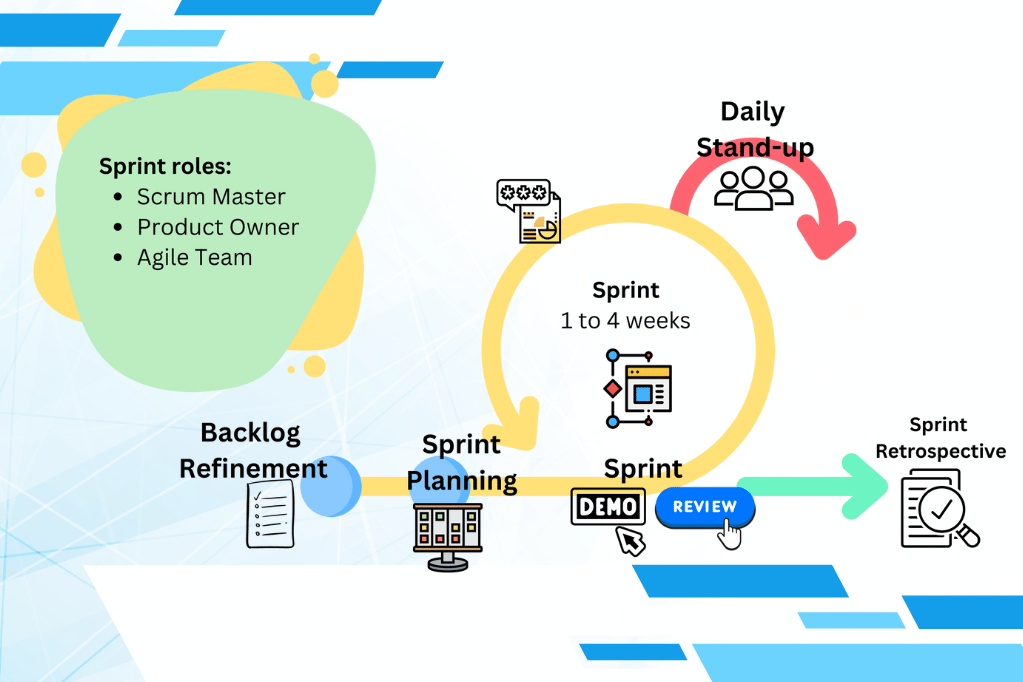Table of Contents
ToggleAgile frameworks, like Scrum, are not just collections of rituals and processes. They’re underpinned by principles designed to deliver quality products and/or services that solve customer problems and meet their needs. Each aspect of the Sprint event in Scrum is a manifestation of these Agile principles, acting as a purposeful step toward achieving the desired outcomes.
In this fifth installment of the agile blog post series that started with the ‘Is Agile Dead?’ post, we elaborate how the scrum framework is implemented and cover topics on cadence, stakeholders & roles, and the key Sprint events—Sprint Planning, Team Syncs (aka Daily Stand-ups), Sprint Review, Backlog Refinement, and Sprint Retrospective. This post is meant to highlight their purpose beyond just the process. It’s not just about knowing the names or the sequence of scrum events or scrum roles; it’s about truly understanding and achieving their intent. Let’s uncover the real essence behind these Agile practices and how they can elevate your team’s performance!
Scrum Framework
The Scrum framework is a structured approach to Agile project management, characterized by its iterative cycles known as Sprints, which provide a cadence to the work being done. Each Sprint is a time-boxed period, typically lasting one to four weeks (commonly adopting two weeks), during which a potentially shippable product increment is created.

Cadence
Scrum operates in a regular, repeating cycle of Sprints. This cadence helps teams to develop a rhythm and predictability, allowing for better planning and execution of tasks. Each Sprint includes several key events designed to foster collaboration and ensure continuous improvement. (To help the team determine the iteration cadence, check out Chapter 15. Selecting an Iteration Length from Mike Cohn’s Agile Estimating and Planning).
Agile Teams
Scrum teams are cross-functional, meaning they have all the skills necessary to complete the work within the Sprint. They are also self-organizing, with team members taking collective accountability for delivering product increments. This structure aligns with Agile principles by promoting team autonomy, fostering collaboration, and ensuring that each team member is fully engaged in the project.
Sprint Events
The Scrum framework includes five main events that are conducted within each sprint:
Backlog Refinement: This event is iterative, but it is also a pre-requisite to Sprint Planning. This event is meant to flesh out the work in the product backlog: user stories, bugs, epics, and/or features. This event aims to clarify the purpose of the work items, set the acceptance criteria, and priority.
Sprint Planning: This event marks the beginning of a Sprint. During Sprint Planning, the team collaborates to define the Sprint Goal and select Product Backlog items to be completed during the Sprint.
Daily Stand-ups or Team Sync: These are brief, daily meetings where team members discuss their progress, plans for the day, and any impediments. This fosters daily communication and ensures alignment.
Sprint Review/Demo: At the end of each Sprint, the team presents the product increment to stakeholders to gather feedback. This event ensures that the product is evolving to meet customer needs and provides an opportunity for course correction if needed.
Sprint Retrospective: Following the Sprint Review, the team conducts a Retrospective to reflect on what went well, what could be improved, and how to make the next Sprint more effective. This continuous reflection drives ongoing improvement.
This event emulates the agile principle on improvement: At regular intervals, the team reflects on how to become more effective, then tunes and adjusts its behavior accordingly.
Roles
The Scrum framework defines specific roles to ensure that everyone has a clear understanding of their responsibilities:
- Product Owner: Responsible for maximizing the value of the product and managing the Product Backlog. The Product Owner represents the stakeholders and ensures that the team is working on the most valuable items.
- Scrum Master: Serves as a facilitator for the team, helping to remove impediments and ensure adherence to Scrum practices. The Scrum Master also helps promote a culture of continuous improvement. More recently, Scrum Masters are also considered as the team coach of the agile team.
- Agile Development Team: A group of professionals who do the work of delivering a potentially releasable increment of “Done” product at the end of each Sprint. They are self-organizing and cross-functional. They have all the required skills to design, plan, execute, and improve in building good products to the team’s target customer(s).
Implementation of Agile Principles
The Scrum framework robustly implements Agile principles through its defined roles, events, and iterative cadence. By continually inspecting and adapting processes and products, promoting close collaboration, emphasizing working software as a measure of progress, and fostering an environment where the team regularly reflects and improves, Scrum creates a dynamic environment that is responsive to change and focused on delivering value. This implementation of Agile principles ultimately leads to the successful delivery of high-quality products that meet customer needs.
Conclusion
In summary, the Scrum framework is a powerful tool for implementing Agile principles and achieving business agility. By understanding its purpose and embracing its events, roles, and cadence, teams can foster a culture of continuous improvement and deliver valuable products that meet customer needs. Are you ready to take your organization to the next level with Scrum? Consider implementing this proven approach to drive success in your projects! Keep learning and stay agile!
Happy sprinting!
To learn more about how each of the 12 agile principles is related to scrum events, check out our previous posts: The Agile Mindset Shift: From Doing Agile to Being Agile Part 1 and Part 2.
Resources for Further Learning
Interested in learning more about Agile and the Scrum framework? Here are some additional resources to continue your journey:
Blogs & Articles:
- “What is Agile?” by Atlassian
- “The Principles of Agile Manifesto” by Mountain Goat Software
- “Scrum Framework Explained: How it Works and When to Use It” by Atlassian
